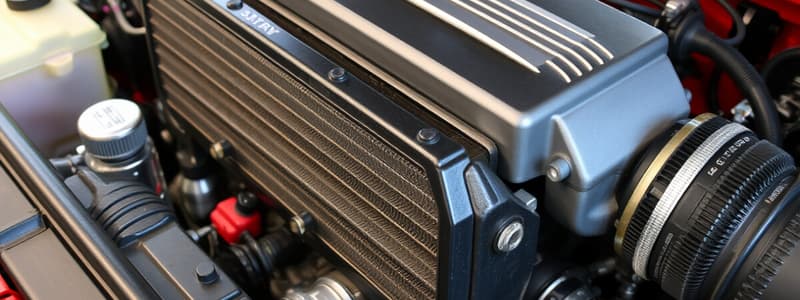Podcast
Questions and Answers
What is the main function of the feed line in the cooling system?
What is the main function of the feed line in the cooling system?
- To circulate oil throughout the engine
- To connect the radiator to the reservoir for coolant movement (correct)
- To regulate the flow of air within the system
- To release excess heat from the engine
Which maintenance task is NOT recommended for the cooling system?
Which maintenance task is NOT recommended for the cooling system?
- Inspect the radiator for leaks or clogs
- Flush the system with water after every drive (correct)
- Regularly inspect coolant levels in the reservoir
- Examine the water pump for signs of wear
What should be done if the pressure cap of the cooling system is found to be worn?
What should be done if the pressure cap of the cooling system is found to be worn?
- It is unnecessary to replace if the system is not leaking
- It should be painted for better durability
- It can be repaired with sealant
- It should be replaced to maintain system pressure (correct)
What is the importance of regularly testing the thermostat?
What is the importance of regularly testing the thermostat?
Which of the following indicators suggests that the hoses in the cooling system need replacement?
Which of the following indicators suggests that the hoses in the cooling system need replacement?
What is the primary purpose of the cooling system in an engine?
What is the primary purpose of the cooling system in an engine?
How does the thermostat function in the cooling system?
How does the thermostat function in the cooling system?
What role does the water pump play in the cooling system?
What role does the water pump play in the cooling system?
What is the main function of a pressure cap in the cooling system?
What is the main function of a pressure cap in the cooling system?
What does the bypass line do in the cooling system?
What does the bypass line do in the cooling system?
Flashcards are hidden until you start studying
Study Notes
Cooling System Overview
- A cooling system regulates engine temperature to prevent overheating and maintain optimal performance.
- It contributes to engine longevity by ensuring it operates efficiently at the right temperature.
Purpose of Cooling System
- Prevent Overheating: Stops the engine from exceeding safe temperature limits.
- Maintain Optimal Temperature: Ensures the engine operates smoothly and efficiently.
- Enhance Engine Performance: Contributes to better fuel efficiency and overall engine function.
- Increase Engine Lifespan: Helps in prolonging the durability and reliability of the engine components.
Key Parts of the Cooling System
- Thermostat: Regulates engine temperature by controlling coolant flow; closes when cold to allow quick warming and opens when the desired temperature is reached.
- Radiator: Cools hot coolant through heat dissipation; features:
- Upper Tank: Receives heated coolant.
- Tubes and Fins: Transfer heat to the air.
- Lower Tank: Collects cooled coolant for recirculation.
- Water Pump: Circulates coolant throughout the engine and radiator to maintain consistent cooling.
- Bypass Line: Allows coolant circulation when the thermostat is closed, preventing overheating prior to engine warming.
- Pressure Cap: Seals the cooling system, increasing boiling point and preventing coolant from vaporizing; has a valve to release excess pressure.
- Coolant Reservoir: Stores excess coolant and allows for reintroduction into the system as needed during temperature fluctuations.
- Feed Line: Connects the reservoir to the radiator to maintain proper coolant levels and flow.
Maintenance Tips for Cooling System
- Check Coolant Levels Regularly: Ensure coolant reservoir is filled to prevent overheating.
- Inspect Radiator: Look for any leaks, damage, or blockages in tubes and fins; clean any debris to maintain airflow.
- Test Thermostat Function: Confirm that it opens and closes at the appropriate temperature.
- Examine Water Pump: Listen for unusual sounds indicating wear; check for leaks and replace if necessary.
- Inspect Hoses and Bypass Line: Look for cracks, leaks, or bulges; replace any damaged components to prevent coolant loss.
- Check Pressure Cap Integrity: Ensure it seals tightly and maintains system pressure; replace if worn.
- Flush Cooling System Periodically: Remove rust, scale, and old coolant; refill with fresh coolant to enhance efficiency.
- Monitor Coolant Reservoir Condition: Ensure it is crack-free and coolant levels are optimal; replace if damaged.
- Inspect Feed Line Condition: Ensure it is free from blockages and allows for proper coolant flow between radiator and reservoir.
Studying That Suits You
Use AI to generate personalized quizzes and flashcards to suit your learning preferences.



